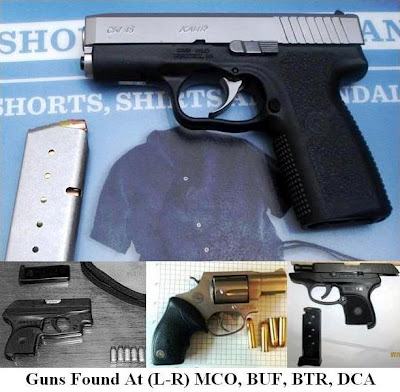Due the holiday, this Week in Review
covers June 28th through June 5th.
Grenades Galore – In case you haven’t heard, grenades and planes do not
mix. Inert grenades were discovered at DSM, SEA, TPA, and BNA. Two live smoke
grenades were discovered at DEN. Read here
and here on
why inert items cause problems at checkpoints. We don’t know they’re inert
until we check them out and checking them out can often inconvenience your
fellow passengers.
Stun Guns – 11 stun guns/devices were discovered in
carry-on bags at checkpoints around the nation at: ORD, OGG, SMF, RIC, JAX,
LGA, FLL & DEN. Among these items were a stun pen at Ketchikan (KTN) and a
stun cane at McGhee - Tyson (TYS). Yes, a stun cane! That’s a first for the Week
in Review posts…
Items in the Strangest Places - It’s one thing to forget you had a prohibited item in
your bag, but when you intentionally try to sneak it past us, you could wind up
being cited or even arrested by law enforcement. Here are a few examples from
this week where passengers tried to sneak items past our Officers.
A razor knife was discovered in the seat
of a wheelchair at Salt Lake City (SLC).
A 4” knife was discovered concealed
inside a comb at Baltimore (BWI).
A 3 ½” knife was found concealed in the
lining of a bag at LaGuardia (LGA).
Kids Pack the Darndest Things – Even though a 9-year-old’s grandmother
packed their bag, the child went in later and added 6 ground bloom fireworks. I
can see why they wanted them. My 9-year-old self probably would have packed
them too. These fireworks were discovered at Milwaukee (MKE).
Automotive Flares: Keyword “automotive.” Not only are automotive flares
prohibited on aircraft, the look a little creepy due to their resemblance to
dynamite sticks. Two of them were discovered at Phoenix (PHX) in a passenger’s carry-on
bag.
Body Scanner
Discoveries This Week –
There were a total of 18 illegal items discovered this week with the body
scanners at: ITO, ATW, JAX, PIE, 2 at ATL, ABQ, TPA, 2 at SMF, LAX, SFO, CLE,
SEA, MSY, PDX, MDW, and LAS. Items were found in hands, pockets, and concealed
in the groin area.
Miscellaneous
Prohibited Items - In
addition to all of the other prohibited items we find weekly, our Officers also
found firearm components, realistic replica firearms, stun guns, brass
knuckles, ammunition, batons, and a lot of bladed items.




Firearms - Here are the firearms our Officers found
in carry-on baggage since I posted last Friday.
Unfortunately
these sorts of occurrences are all too frequent which is why we talk about
these finds. Sure, it’s great to share the things that our officers are
finding, but at the same time, each time we find a dangerous item, the
throughput is slowed down and a passenger that likely had no ill intent ends up
with a citation or in some cases is even arrested. This is a friendly reminder
to please leave these items at home. Just because we find a prohibited item on
an individual does not mean they had bad intentions, that's for the law
enforcement officer to decide. In many cases, people simply forgot they had
these items.
If you have a
travel related issue or question that needs an immediate answer, you can
contact us by clicking
here.

